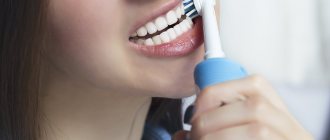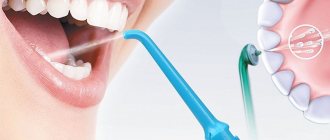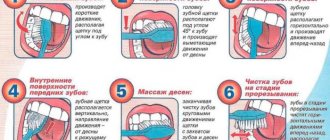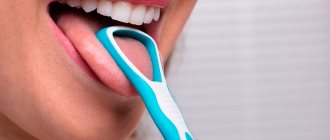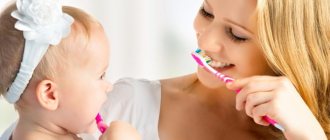Professional hygienic cleaning of teeth and oral cavity at the dentist - what is it, how is such a procedure carried out? Doctors recommend using this method once every six months. During one visit to the dental office, a whole range of measures is carried out: plaque and hard deposits (stone) are removed, inflammatory diseases are prevented, and the general condition of the dentition is improved.
Currently, there are several methods of cleansing, which include laser, ultrasound, and the modern “Air Flow” technique. Carrying out a hygienic procedure in dentistry has many advantages and is popular among patients.
Why brush your teeth?
You need to learn how to care for your mouth from early childhood. Of course, children 8–9 months old (the time the first tooth erupts) are not able to do this on their own. Parents should show their concern here.
Plaque on the surface of the enamel is an accumulation of large amounts of tiny food debris. If oral care is not taken on time, plaque increases. Combining with saliva, it mineralizes and becomes a stone that cannot be removed only with a brush. Important: the stone causes caries, periodontitis and other diseases. Caries is a trigger that essentially causes a chain reaction.
Caries and periodontitis
The structure of enamel is naturally porous and rough. Plaque on the surface fills the pores, causing inflammation. This is caries. If no measures are taken and prevention is not carried out, the disease spreads deeper. Over time, the inflammatory process spreads to the gums and roots.
Periodontium is the tissue surrounding the root of the tooth. It fixes it in the bone structure of the jaw. Inflammation in this area leads to the formation of a cyst.
Periodontitis
Destruction of the supporting apparatus of the tooth. At the same time, the gum gradually moves back and a pocket appears. This is where food debris accumulates. It is impossible to remove them yourself. Against this background, the gums swell, begin to bleed, and become sensitive during chewing. Purulent formations may appear in the pocket. Untimely treatment leads to loosening, displacement, and loss of teeth.
Important! Periodontitis is the second most common disease after caries. According to WHO, this pathology is diagnosed in 75% of children and 93% of adults.
Periodontal disease
According to statistics, out of 10 patients, periodontal disease is observed in 6 people. The disease is characterized by impaired blood supply to tissues. This leads to their degeneration and exposure of the neck of the tooth. The gums gradually rise above each other. At the same time, they do not turn red, do not swell, do not bleed, but simply slowly collapse.
Usually the disease affects both jaws at once.
Tooth loss
It needs to be prevented from early childhood. Parents do not always think about the consequences of premature tooth loss in their child. The thinking of some fathers and mothers is as follows: why treat caries of children’s teeth, because they are baby teeth and will soon fall out. This is a big misconception. By affecting baby teeth, caries leads to their premature loss.
Nature intended that the permanent tooth should replace the milk tooth, pushing it out. This order is a normal process. With premature loss, physiology is disrupted, which leads to improper eruption, crooked teeth and changes in bite. Such transformations entail many problems - impaired diction, deformation of facial features, gastrointestinal diseases. Adults experience the same problems when their teeth fall out.
Gastrointestinal diseases
Incorrect bite and lack of proper number of teeth affect the process of grinding food. Insufficiently chewed food ends up in the stomach, which finds it difficult to digest such food. As a result, gastric juice, which contains hydrochloric acid, is released abundantly. A large amount of it irritates the walls of the stomach. Over time, they become inflamed and gastritis develops. In case of untimely treatment, the pattern of disease development is probably known to everyone: gastritis - ulcer - oncology. And it is not a fact that the inflammatory process will not reach the duodenum or intestines.
Chronic pathologies
It would seem, what is a raid? A small buildup on the enamel surface that can be removed with a brush. But many pathogenic bacteria live in this area. If you do not clean the oral cavity, bacteria can migrate through the bloodstream (especially if the integrity of the gum tissue is damaged), move to the tonsils, and into the sinus area. This way the infection can reach any organ.
Think about the numbers! Out of 10 children with early caries, 9 suffer from chronic diseases of the respiratory and ENT organs! According to statistics, caries in childhood causes the development of a chronic form of sinusitis and tonsillitis.
A migrating infection can cause meningitis and provoke encephalitis. Diseases are difficult to treat, their consequences are terrible - dementia, disability.
In medical practice, there are known cases of death from sepsis. The cause is a bacterial infection that first caused tooth decay and then entered the bloodstream and caused sepsis. This advanced disease and its untimely treatment leads to death.
Psychological problems
In childhood, malocclusion becomes the result of crowded teeth, changes in facial features, and impaired diction. Often children feel awkward and begin to develop complexes. In the future, insecure people, already adults, cannot arrange their personal lives. In most cases, the lack of a smile is due to embarrassment and reluctance to talk again.
Psychologists say that in 15% of cases, alcoholism, drug addiction and teenage suicide are associated with complexes about appearance. 10% of them relate specifically to impaired diction and a deformed face due to malocclusion.a
So, caries caused by plaque can cause a lot of negative consequences. This can be avoided by maintaining oral hygiene and paying due attention to your health.
Cleaning methods at the dentist
Professional hygienists and periodontists use a whole arsenal of methods for cleaning teeth. This can be the simplest influence (instrumental) or more advanced (Air Flo, ultrasonic, etc.). Which option to choose depends on the following factors:
- the patient’s health status, his well-being;
- thickness, structure, density of plaque or stone;
- age (some activities are contraindicated for children);
- location of formations;
- financial opportunities.
It is also possible to use several techniques for complex effects. In this way, you can speed up the onset of a positive result and prolong the effect for up to six months or more.
Mechanical (manual)
One of the oldest methods, which does not lose popularity due to its affordable price. The use of expensive equipment is not required here; the doctor uses special tools with hooks to remove hard deposits.
The procedure has a significant drawback. As a result of mechanical impact, the enamel may be damaged. It cannot be performed if a person has hypersensitivity. In some situations, this option is the only acceptable option if there are contraindications.
Using the Air Flow system
What is included in professional teeth cleaning with Air Flo: the teeth are treated with a mixture of water, abrasive particles and air. All this is supplied under a certain pressure. The layer is easily removed without causing any discomfort to the patient, and the structure of the units is not affected. The enamel becomes several shades lighter. Unfortunately, such a delicate method cannot get rid of old deposits.
Ultrasonic
Ultrasound crushes the hardened layers, and their particles are then washed out with water. This way you can remove plaque and stone not only from visible surfaces, but also from hard-to-reach places (for example, in the spaces between teeth). If the accumulated layer was too hard and old, discomfort may be present for several days.
Laser
The laser beam removes old deposits. The person does not experience pain or other discomfort; the incisors, canines and molars remain intact. The condition of soft tissues improves. In addition, the method helps disinfect the oral cavity. The procedure will cost more than other types of cleansing.
Polishing
In this way, the dentist eliminates unevenness and microcracks on surfaces that formed after applying the above methods. If you skip this step, the enamel will be rough and food particles will be trapped on it. As a result, plaque will very quickly accumulate again, harden and turn into stone.
How is hygienic teeth cleaning done, are special tools needed? Hard fabrics are polished using special devices alternating different types of attachments, such as:
- needle-shaped (for grinding);
- brushes (clean out leftover food);
- polishers (process crowns and dentures);
- discs (give perfect smoothness and shine);
- strips (for interdental spaces).
Fluoridation
This is an optional procedure, but it is still worth agreeing to it. It helps overcome sensitivity, strengthen enamel, and prevent the appearance of carious lesions. Surfaces are treated with special substances – fluorides.
Pros:
- the level of fluoride in the body is normalized;
- the strength of dental units increases;
- the leaching of calcium, which affects vital processes in the skeletal system, is stopped;
- the growth and reproduction of pathogenic microorganisms slows down.
What does the doctor do:
- drying is performed with a jet of air;
- a solution enriched with active ingredients is applied with a brush or using trays;
- recommendations for prevention are given.
Fluoridation is the final stage of purification in a clinical setting.
How often should you brush your teeth?
Dentists recommend caring for your oral cavity 2 times a day (morning and evening). But the hygiene procedure does not end there. To prevent the development of caries, it is necessary to rinse your mouth after every meal. It doesn’t matter whether a person ate an apple, cracked seeds, or had a full lunch.
Intensive rinsing removes harmful bacteria and stuck food pieces. It is, of course, advisable to use special foams or rinses. You can make a solution of salt and soda (1 tsp per 0.5 liter of water). But if this is not possible, then at least use a floss and rinse your mouth with water.
The fourth stage - fluoridation
As a rule, fluoridation is not included in the calculation of comprehensive professional hygiene, but it is very important for dental health. The application of fluoride helps strengthen the enamel layer (prevents the leaching of calcium), reduces hypersensitivity, prevents the onset of caries (slows down the proliferation of pathogenic bacteria). Therefore, you should not refuse this procedure. Fluoridation algorithm: the doctor dries the surface to be treated with a warm air stream, then applies fluoride varnish (a harmless composition based on varnish with a high concentration of fluorides) to each element of the dentition, then dries it.
Note: after completing all stages of comprehensive cleansing, teeth become noticeably lighter, reaching their natural natural color. But those patients who dream of a snow-white smile can resort to whitening, for example, using the ZOOM-4 method.
How to choose a toothbrush
Not only is the correct cleaning technique important, but also the brush. When choosing a product, you need to navigate their diversity:
- Very soft brushes designed for children. This type is chosen for children over 5 years old, as well as people diagnosed with periodontitis. It is recommended that children under 2 years old brush their teeth with special silicone fingertips.
- Medium bristles hardness. Recommended for teenagers over 12 years old.
- Hard brushes. Can only be used after consulting a doctor. Excessive hardness causes enamel destruction. Recommended for coffee lovers, smokers, and people with increased stone formation. But such brushes can only be used by those who have strong enamel and a healthy oral cavity.
- Very hard brush. We are talking about brushes used in cases where bridges and braces are installed.
- Electric brushes. According to dentists, they are best for removing soft deposits. In addition, there is no need to make additional movements during cleaning. It is enough to slowly move the device over the surface of the teeth, and the electric brush will do the rest itself. But if the gum tissue is weak, then such a procedure can cause injury.
- Ultrasonic brushes. Does not damage gums. Approved for use for diseases of the oral cavity, installed braces or implants. Ultrasound cleans exposed surfaces and removes bacteria at a depth of 5 mm under the gums.
- Working head size. Preference should be given to products with small working heads. In this way, soft tissue injury can be prevented.
Pay attention to the hardness level markings. Responsible manufacturers always indicate it on the packaging:
- sensitive – very soft brushes;
- soft – soft;
- medium – brushes with medium hardness;
- hard – very hard;
- extra-hard – special brushes that remove large amounts of plaque and are intended for people with installed restoration structures.
An important rule: you need to change the brush every 3 months.
Contraindications to the procedure
Like any medical procedure, professional dental hygiene has contraindications:
- age under 18 years;
- inflammatory diseases of the oral cavity;
- foci of caries;
- bronchial hyperreactivity (in patients with asthma, allergies, obstructive bronchitis);
- severe thinning of the enamel layer;
- bruxism;
- some mental pathologies;
- chronic diseases in the acute phase;
- infectious pathologies;
- a large number of filled teeth;
- epilepsy; open form of tuberculosis;
- wearing braces and metal crowns.
Most contraindications are relative. The patient can undergo the procedure after recovery.
Choosing a toothpaste
Almost all pastes are therapeutic and prophylactic. Serve for mechanical cleansing and help prevent caries, periodontitis, and periodontal disease. To do this, the composition includes various components that should be taken into account when choosing a care product:
- Fluorides and calcium. Included in the composition for the prevention of caries and restoration of enamel structure.
- Medicinal plants, essential oils, antiseptic substances (chlorhexidine, triclosan). Eliminate bleeding, swelling of the gums, remove plaque.
- Potassium, strontium, aminofluoride, hydroxyapatite. Reduce tissue sensitivity and relieve pain.
- Enzymes (papain) and antimicrobial substances (lysozyme, lactoferrin, lactoperoxidase). Added to whitening pastes to increase the effectiveness of plaque removal.
- Vitamin complex (A, E, C, B, carotoline). Improves metabolic processes, accelerates the healing of the mucous membrane.
You need to choose a paste depending on your existing dental problems. Don't get carried away with fluoride-containing toothpastes. If there is an excess of fluoride, fluorosis can develop. Therefore, fluoride-containing toothpastes are used no more than once a day.
Step-by-step instruction
Cleansing takes 3 minutes! Particular attention should be paid to hard-to-reach areas: gum line, interdental spaces.
Cleaning scheme:
- Wet the brush with warm water.
- Apply the paste in a thin strip to the brush.
- Start cleansing from the upper jaw. First, treat the outer molars and chewing teeth behind the cheeks.
- The direction of movement is from left to right. If you are left-handed, it is better to start on the right.
- The basic rule of the technique is to place the brush parallel to the gums.
- Do not press too hard on the brush.
- Movements are circular, brush each area for 10 seconds. During this time, make 10 movements with the brush.
- Then start brushing from the gums to the bottom edges.
- Next, treat the inner surfaces in the same way.
- Clean your tongue and inner cheeks.
- Rinse your mouth, changing the water 3 times.
Don’t forget to wash your brush and treat it with an antiseptic after each procedure.
Toothpicks and chewing gum
Dentists do not recommend using toothpicks at all. The wood from which they are made flakes when cleaned. The separated particles can remain between the teeth and, over time, begin to rot and cause inflammation. And also, while using a toothpick, you can injure your gums without even noticing it. Alternatively, use thread.
It is a mistaken belief that chewing gum will help get rid of plaque and stuck pieces of food. Yes, undoubtedly, some parts of the remaining food will stick to the gum. But during the chewing process, when the gums press against each other, these same particles can get stuck in the interdental space.
In addition, recently placed fillings that have not withstood prolonged exposure “like” to stick to chewing gum.
Chewing gum does not strengthen the gums; this happens in the process of uniform chewing, and not when squeezing the jaws in one place. Chewing gum is usually one-sided and can lead to muscle atrophy on the opposite side because it will not receive the stress it needs.
Another disadvantage is that constant chewing will lead to overload of the periodontium. Against this background, periodontitis and gingivitis can develop.
Chewing gum contains dyes and sweeteners. Do not forget that dye E131 (contained, for example, in Stimorol chewing gum) causes the formation of cancer cells, E171 – liver and kidney diseases.
To remove food debris after eating, it is better to rinse your mouth with water 2-3 times or use a mouthwash or foam.
Which brush to use
As we found out earlier, you should choose a toothbrush based on the sensitivity of your teeth. Dentists recommend using brushes with low or medium hardness.
Stiffer brushes can only be used as prescribed by a specialist and all recommendations are followed. Otherwise, you may damage the surface of your teeth and soft tissues.
Electric toothbrushes are not as effective as they might seem. They do not sufficiently clean the surface of the tooth and drive food debris into the space between the tooth and gum. It is better to opt for a regular brush with a hardness that suits you.
How to properly brush teeth with braces
With braces installed, teeth must be brushed 3 times a day. Regardless of whether you have removable braces or not, cleaning should first be done in the standard way using a brush and paste.
A prerequisite for braces and veneers is the use of an irrigator. This device uses a thin stream of liquid under high pressure to efficiently clean the enamel, gum pockets and the space between the teeth from fresh and old plaque.
Third stage - polishing
Deposits leave microcracks and irregularities on the enamel layer. Therefore, polishing is necessary after cleaning procedures. Otherwise, the remaining roughness will become a “magnet” for microparticles of food, which will very quickly turn into new deposits. Polishing is performed using abrasive pastes and various attachments driven by a drill. These are polishers, brushes, discs, needle-shaped attachments. The interdental areas are polished with special strips. The process does not cause pain and takes about 40 minutes.
How to properly brush your teeth with an electric brush?
The electric brush can make up to 25 thousand rotations per minute. Therefore, the cleansing procedure takes less time.
There are more powerful brushes, for example, from. They make up to 45 thousand rotations per minute.
The usage scheme is, in principle, standard. You don't need to strain or make any movements. She works on her own. The brush should be held parallel to the teeth, without pressing, and moved along the surface.
The procedure time is 1.5–2 minutes.
Dr. Zubastik recommends
After each procedure, rinse the brush. Do not store children's and adult teeth-cleaning devices in the same place - the infection can easily spread to neighboring hygiene products.
Interesting! Ancient people ate food given by nature itself, receiving a large amount of vitamins and a massage effect for the gums. They lived to old age, keeping all their teeth in excellent condition. Our ancestors ate rough, solid food and fruits without using a knife. According to anthropological researchers, ancient man did not know caries. The lack of teeth could only be a consequence of surviving and fighting the beast.
Tags: braces, toothbrush, toothpicks, teeth cleaning
About the author: Dr. Zubastik
Typically, a toothache begins to subside on the way to the clinic and finally goes away after 10 minutes of sitting in line to see the dentist.
- Related Posts
- 12 best whitening toothpastes of 2022: which toothpaste is best for whitening teeth?
- How to choose the right irrigator: advice from a dentist
- Everything about caring for children's teeth
« Previous entry
Rules for using floss
Waxed dental floss glides easier between teeth, has a denser structure, and is less susceptible to delamination. Such threads are very elastic, so when used, the risk of damaging the delicate gum tissue is lower. They are suitable for beginners. Floss is not a replacement for a toothbrush! It should be used after meals, as well as before morning and evening brushing of teeth.
Due to the splitting of the fibers, unwaxed dental floss adheres more firmly to the surface and cleans teeth better. The right thing to do is to floss over each tooth until a characteristic squeak appears. The technique should first be practiced on waxed dental floss.
Fedorova Yana Valentinovna
Dentist-therapist-periodontist, AktivStom clinic
If you select and use dental floss incorrectly, you can injure the gingival papilla, which will lead to bleeding and pain. In this case, the procedure must be suspended for 2-3 days. It is recommended to apply Metrogyl Denta ointment or Asept adhesive gum balm to the damaged area.



